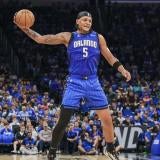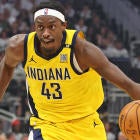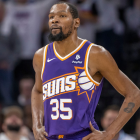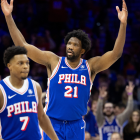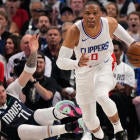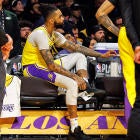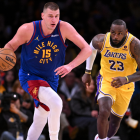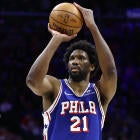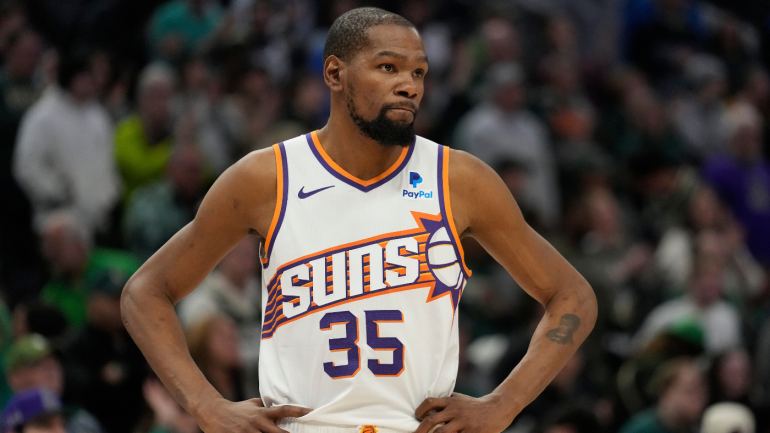
We're neck-deep in the NBA's "all in" era, and that's especially true in the Western Conference. In the last year or so alone, both the Minnesota Timberwolves (Rudy Gobert) and Phoenix Suns (Kevin Durant) have traded at least four first-round picks for a star. The Clippers gave up two for James Harden, and considering the picks they were already out, they won't control their own first-rounder again until 2028. The Mavericks control just two of their next seven first-round picks. The Los Angeles Lakers are built around a 39-year-old LeBron James. The Golden State Warriors are built around a 36-year-old Stephen Curry. Both of them are operating at pick deficits as well.
But here's the rub: the basic math of the NBA hasn't changed. Teams are surrendering more assets than ever and building around more older stars than ever in order to maximize their short-term championship odds... but only one team actually gets to win the championship, same as it's always been. Only one of those teams can win the West, and there's a possibility, perhaps even a probability, that none of them will. In fact, the West is so deep that most of them probably won't make it past the first round.
There's a reckoning coming. Eventually, the dust is going to settle and out of the 10 teams that reach the Western Conference postseason, seven or eight are likely going to find themselves disappointed with how their season ends. That's going to force some introspection and hard-decision making. The Nuggets aren't going anywhere. The Thunder will only get better. Victor Wembanyama will be ready before anyone knows it. Things aren't going to get easier.
So as we approach a postseason that is going to have a lot more losers than winners, let's prepare for the aftermath of those inevitable disappointments and take a look at how each of our 10 Western Conference postseason teams might respond to an early postseason exit.
Tier 1: This is fine
- Denver Nuggets
- Oklahoma City Thunder
The Nuggets and Thunder might be the two best teams in the Western Conference, but neither has hit their championship odds peak quite yet.
The only real age-related decline Denver has to worry about comes from the 31-year-old Kentavious Caldwell-Pope, but just take a look at their bench. Christian Braun and Peyton Watson both have two more years of team control. Julian Strawther has three. Zeke Nnajji has four. All of them are 23 or younger. Denver sacrificed future draft capital last summer with the idea that immediate picks could supply them with cheap depth for the entirety of their championship window. Considering how well those players have handled their roles at such young ages, it seems as though they've succeeded. The Nuggets are positioned to contend for at least the next three years. Things get more complicated when it's time to pay the younger guys, but so long as Nikola Jokic is in his prime, Denver should remain relatively strong.
The Thunder are positioned to contend even longer. All five of their starters are 25 or younger. Shai Gilgeous-Alexander may win MVP and both Jalen Williams and Chet Holmgren are going to be All-Stars sooner rather than later. Their war chest of draft picks is as deep as ever. Oh, and the cherry on top? They are not only positioned to create max cap space this offseason if they want to, but they could also choose to carry that space into the summer of 2025 if they'd prefer. Holmgren and Williams start their next contracts in the summer of 2026, so the Thunder still have two years of cap flexibility to reshape the team as they see fit. They'll eventually have to make hard choices, but it's fair to say that no team in NBA history has ever had as much roster optionality as the Thunder. Only injuries could deprive them of long-term contention.
All of this is part of what makes the situation for the teams below Denver and Oklahoma City so dire. They're all already worse than the Nuggets and Thunder... yet they may never have better chances to beat them. The top two seeds in the West are getting stronger. Most of the teams we'll cover below are getting weaker.
Looking for more NBA coverage? John Gonzalez, Bill Reiter, Ashley Nicole Moss and special guests dive deep into the league's biggest storylines daily on the Beyond the Arc podcast.
Tier 2: Still some upside and maneuverability
- New Orleans Pelicans
- Sacramento Kings
- Dallas Mavericks
The Pelicans have a looming financial crunch coming. Jonas Valanciunas expires after this season, but retaining him at a somewhat similar number given his age shouldn't be a problem. No, the problems come in the summer of 2025. That's when Brandon Ingram's contract expires. Trey Murphy's rookie extension, which will be hefty, kicks in for the 2025-26 season.
And then there's Jose Alvarado. The Pelicans could keep him for next season at his dirt-cheap $2 million team option, but they're likelier to take the approach they used on Herb Jones last offseason: let him become a restricted free agent now and lock him into a team-friendly long-term deal now before he becomes unrestricted in 2025. That's all well and good, but retaining all of those players with Zion Williamson and C.J. McCollum on big deals would take the Pelicans deep into the tax. The Pelicans have never paid the tax. Something is going to give here. Expect someone of note to be moved.
But remember, the core of this roster is still very young. They control all of their own first-round picks and three future picks from the Lakers and Bucks, plus two Bucks swaps. New Orleans is still reasonably maneuverable. David Griffin is a creative GM and Willie Green is a good coach. Things are going to get harder for the Pelicans, but they aren't really an "all-in" team so much as they are built to keep one foot in for the foreseeable future while retooling as needed.
The Kings could have made more of an all-in push last summer. Instead they used their cap space to give Domantas Sabonis a raise earlier than they needed to. Now they're facing the unenviable task of trying to re-sign Malik Monk without full Bird Rights. As the Kings are an over-the-cap team, they'll only be able to offer Monk a new deal starting at around $17.4 million. That might be able to keep him. It might not. If they do retain him, they start to flirt with the tax. Fortunately, they still have two more years of rookie contract team control on Keegan Murray, so hefty tax bills are still years off.
More importantly, the Kings are very well-positioned to improve through trade this offseason. They'll either control all of their own future picks starting in July, or they'll owe one pick to the Hawks from the Kevin Huerter trade while retaining a lottery selection in 2024. Either way, they have assets. They also have a number of mid-tier salaries to trade if they want to consolidate for a bigger name. Having Keon Ellis for pennies on the dollar for the next two seasons doesn't hurt either. The Kings overperformed last season. They made the very intentional decision to run it back and evaluate what they had. This summer will be their moment to improve, and the all-in clock will start then. For now? They're in a pretty good spot.
Dallas is right on the edge between Tiers 2 and 3. Most of next season's roster is locked in, but they're already nearly at the projected tax line. That wouldn't be a concern if Mark Cuban was still running the show. Even if he's nominally in control of basketball operations, we don't know what sort of appetite these new owners will have for spending. The Mavericks will need to add salary to meaningfully improve.
But Dallas has a number of things going for it that the next group of teams don't. The biggest is cost-certainty. Their 11 highest-paid players are all locked in for next season. There isn't a bad contract among those deals, meaning Dallas should be able to trade relatively freely. Many of their contracts are quite valuable for starting-level players. Daniel Gafford, for instance, appears to be somewhat underpaid. Dereck Lively is even cheaper with three years left on his rookie deal.
Lively is the key here, but he's part of a broader trend: the Mavericks have emphasized youth since last offseason. Lively is the only major upside play, but Gafford and P.J. Washington are still only 25. Josh Green is 23. Last year's other first-round pick, Olivier-Maxence Prosper, is just 21. Yes, there's age-related fear for certain players. Kyrie Irving is the most notable, but Tim Hardaway Jr., Maxi Kleber and Dwight Powell are all in their 30's. If the Mavericks were having this sort of season with exclusively older players, it would be DEFCON1.
But let's be honest, all that matters here is Luka Doncic's continued long-term faith in this organization. The youth here gives him a reason to maintain optimism... at least for now. But the clock is ticking on Dallas a bit more loudly than Sacramento or New Orleans, and the Mavericks don't have nearly the same asset-base to work with unless Lively is on the table (which he categorically should not be). Dallas can trade its 2025 and 2031 first-round picks this summer. Doing so will likely be a prerequisite to contending seriously. The Mavericks need serious defensive improvements. Those don't come cheap. But they're gettable. The Mavericks don't have the deeper structural issues the rest of these teams have. They have an MVP candidate in his prime, reasonable finances and at least some asset flexibility to improve.
Tier 3: Not great, Bob!
- Minnesota Timberwolves
- Golden State Warriors
- Los Angeles Lakers
The projected second apron for next season is $190 million. After Mike Conley's extension, the Timberwolves are sitting at around $186 million in committed salary for nine players. If Anthony Edwards makes an All-NBA Team as expected, his salary for next season will rise by around $7 million thanks to the Derrick Rose Rule. That would push the Timberwolves above the second apron with 40% of a roster still to add. Key reserves Monte Morris and Kyle Anderson are not under contract for next season.
That is already a very precarious situation. The new ownership coming in makes things even scarier. Given the unusual payment timeline of the sale as well as some of the financing issues they're reportedly had, it's just hard to believe that Marc Lorre and Alex Rodriguez are going to be especially enthused about paying an enormous luxury tax bill in their first season. That might have changed if the Timberwolves had made a serious push for the championship this season. They still could, but with Karl-Anthony Towns currently injured, that seems unlikely. The likeliest outcome here is some sort of salary-shaving move.
What would that mean? Well, we'll start with the obvious... trading Towns makes the most sense. He's set to make over $49 million next season when his super max deal kicks in. That contract locks him up for four years. It's not even clear if the league will view that as a positive-value deal for a player who turns 29 early next season. Even if Minnesota could get off of his deal, they likely wouldn't be getting win-now players in the process. To get fair value, the Timberwolves would probably need to trade either Naz Reid or Jaden McDaniels. Doing so would do more harm than good. They are both young and frankly underpaid. At a bare minimum, the Timberwolves are going to lose a bit of depth when Anderson and Morris walk. More likely, they lose someone more important, and with very little remaining draft capital to improve with and a still-dire financial situation, this year is probably Minnesota's best chance with this core.
The Warriors are about to get a bit of financial relief. The contracts of Klay Thompson and Chris Paul expire this wummer. But it's not as though the Warriors can just turn around and immediately use this flexibility to improve. Jonathan Kuminga's inevitable extension will kick in after next season, and the Warriors have to prepare for that. It's not even clear if the Warriors are going to prioritize improvement. They're a play-in team right now. Owner Joe Lacob admitted recently that he would prefer the team to avoid the luxury tax entirely next season. Doing so while retaining Thompson and Paul would be difficult.
There are pathways to improvement here. Perhaps they can include their remaining draft capital in a deal with the hefty contract of Andrew Wiggins to get back something noteworthy. But their best player just turned 36. Thompson and Draymond Green aren't far behind. That's a significant constraint.
You know what's worse than having a 36-year-old as your best player? Having a 40-year-old as your best player. That's the situation that the Lakers are staring down right now. LeBron James and Anthony Davis have combined to miss 14 games all season. What are the odds that the Lakers get such healthy seasons out of them next season? And how have the Lakers taken advantage of the golden opportunity the health of their stars has presented them? They're 37-32. Injuries to the supporting cast are part of that, but there's a far simpler explanation here: the Lakers don't have a single 3-and-D player on the roster. There are five Lakers averaging at least one made 3-pointer per game this season. None of them have a defensive EPM of even plus-1. James is the only one of them with a positive defensive EPM.
But OK... that's a fixable problem. Even as a repeater tax payer for next season, the Lakers have built a reasonably fluid roster. They have four players set to make between $10-17 million next season, and D'Angelo Russell could come in at around $18.7 million if he picks up his player option (unlikely but not impossible). Those are tradable salaries. They'll have three first-round picks to deal this offseason as well. This roster can be tweaked fairly easily.
So who have the Lakers been linked to most? Trae Young. Doesn't sound like they're looking at 3-and-D players, does it? That's the real problem here. Nothing the Lakers have done since winning the 2020 championship suggests that they as an organization understand what this team actually needs. They continue to prioritize flashy scorers and ball-handlers over the blue-collar role players that actually helped them win it all four years ago. Even if James was still in his prime, he doesn't play for a team that understands what he needs to succeed. So long as that is true, he is only going to age away what remains of his superstardom on slowly decaying rosters.
The Athletic's Jovan Buha reported in January that head coach Darvin Ham is expected to be "safe through the end of the season." Well... what happens if the season ends with a play-in loss? It's hard to say. To put it bluntly, this has been a bad season for Ham. His lineups for the first three months or so of the season were nonsensical. The Lakers have lost a lot of games based on how slowly he adjusts, if he does at all. For example, Dante Exum has made 40 3-pointers all season. Nine came in a single game against the Lakers because Ham refused to adjust to his hot streak and actually guard him. When there were rumblings about his job security earlier this season, there wasn't a public outcry from the players in his defense. Buha and Shams Charania reported that there was a disconnect between him and the locker room in early January.
But still, without firm reporting on the matter, it seems hard to believe that the Lakers would give up on Ham only a year after he took them to the Western Conference Finals. Remember, Rob Pelinka has already been involved in the hiring of three coaches. No GM wants to explain to his owner why he should be allowed to hire a fourth. All of the reporting during the rocky times in January suggested that Ham has the support of Pelinka and Jeanie Buss. Those are the two key decision-makers here, and purely from a self-preservation perspective, it's hard to imagine Pelinka being able to sell a coaching change to Buss. Remember, the Lakers fired Frank Vogel two years after a championship. He didn't trade for Russell Westbrook. Pelinka did. Pelinka is the common denominator here. You can only change coaches so many times before an owner realizes that.
Tier 4: The All-In Poster Boys
- Los Angeles Clippers
- Phoenix Suns
Speaking of teams that are unlikely to get similar health out of their stars next season, both Kawhi Leonard and Paul George have played more games this season than they had in any of their previous campaigns with the Clippers. Leonard turns 33 in June. George turns 34 in May. James Harden turns 35 in May. Only Leonard is under contract for next season, but the Clippers are so far above the cap that losing either George or Harden wouldn't give them the cap space they'd need to replace either All-Star. The cherry on top here is that the Clippers don't control any of their own first-round picks until 2030, and of their nine highest-paid players, seven are in their 30s. It's either "now or never" territory for the Clippers or very close to it.
The Clippers can't treat any of their players as scapegoats if this goes south. They have no means of replacing them through trade or free agency. What does that mean for Ty Lue? His contract only goes out through the 2024-25 season, and coaches never coach out the final year of their deals. He'll either be extended by the Clippers this offseason or he'll be gone. There was a fair bit of buzz surrounding Lue last offseason. Both the Suns and Bucks were reportedly interested. Was there anything there? It's hard to say, but such interest rarely gets reported out of thin air. Ultimately the Clippers kept him. If they disappoint this postseason, that's a decision they may revisit.
Frank Vogel seemingly has a bit more job security in Phoenix. He got a five-year deal last summer, and that security likely meant a great deal to him after the Lakers only give him a three-year deal in 2019. Of course, Mat Ishbia hasn't shied away from spending since he took over the Suns last season. It's also worth noting that Kevin Young, Vogel's top assistant and a finalist for the Suns job last year, is still on the staff. If Ishbia wants to make a change, he has a familiar candidate in-house already. It's unlikely, and there's been no reporting suggesting that. But new owners can be impatient, and the Suns, like the Clippers, have a short window.
In theory, the Suns are slightly more flexible than their Los Angeles contemporaries. Devin Booker is still only 27. They'll have two tradable first-round picks this offseason: 2024 and 2031. But this team is going to get walloped by the luxury tax and second apron. They already have roughly $190 million on the books for next season, and that doesn't include new deals for essential role players Grayson Allen or Royce O'Neale. Neither can be replaced in any realistic way. Expect Ishbia to pay somewhere between $25-30 million to retain both this summer, taking his payroll well beyond $200 million.
That takes even the taxpayer mid-level exception off of the table. The new rules relating to the second apron will make things harder as well. The Suns won't be able to aggregate salaries for trade purposes, for instance, so even if they find role players they'd want for those two first-round picks, they have no easy path to actually matching money and getting them. Kevin Durant turns 36 during the offseason. Bradley Beal is still only 30, but he's shown no ability to stay healthy for the long term.
The Clippers and Suns are the poster boys of this all-in Western Conference. Neither are favorites to actually win it. There's a chance both start the playoffs on the road, and in Phoenix's case, perhaps the play-in. Their odds of beating the Nuggets now are on the lower end, but it's only going to get harder from here.











